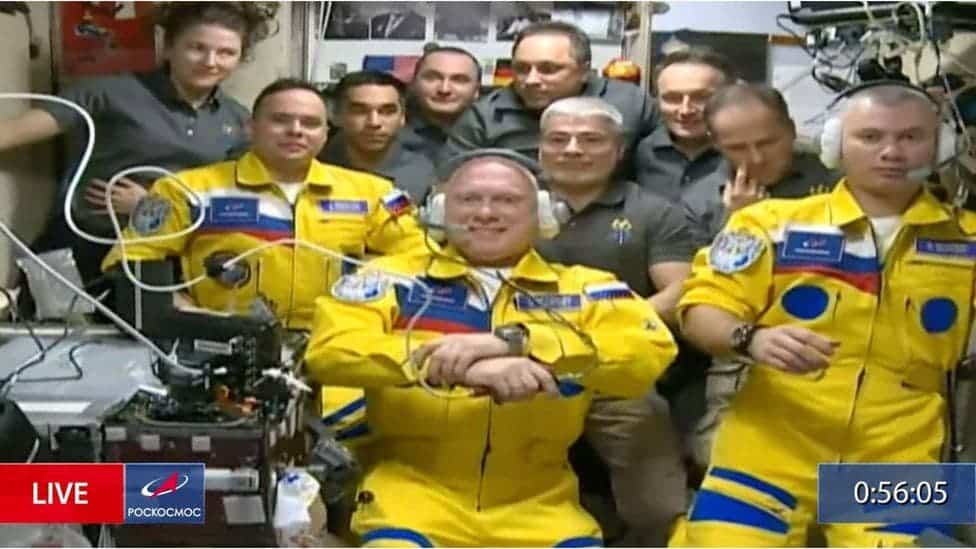
It’s always a reason for joy when astronauts arrive at the ISS, but when three Russian cosmonauts boarded the International Space Station wearing Ukrainian colors, plenty of eyebrows were raised.
Even the impartial BBC couldn’t refrain from speculating. Were the bright yellow suits with blue trimmers a signal? Were the astronauts truly trying to send a message of support to Ukraine?
It’s tempting to think so. At a time when the Russian military is attacking civilians in Ukraine and both companies and governments are sanctioning Russia, we’ve seen plenty of international support for Ukraine, and plenty of Ukrainian flags shown as support. It’s even more tempting to think so because the standard Russian uniform is plain blue, and this is what cosmonauts often (but not always) wear.
In typical fashion, the Russian media disregarded this idea as nonsense.
“Sometimes yellow is just yellow,” Roscosmos’ press service said on its Telegram channel, Reuters reported. Rocosmos, the Russian state corporation responsible for space flights, then added that the suits may be a reference to the cosmonauts’ alma mater:
“The flight suits of the new crew are made in the colours of the emblem of the Bauman Moscow State Technical University, which all three cosmonauts graduated from… To see the Ukrainian flag everywhere and in everything is crazy.”
But one of the cosmonauts seemed to have a different explanation. Oleg Artemyev said it was simply a coincidence, and yellow was the available material.
“It became our turn to pick a colour,” Mr Artemyev said when he was asked about the suits in a live-streamed press conference. “We had accumulated a lot of yellow material so we needed to use it,” he joked. “That’s why we had to wear yellow.”
It’s a bit peculiar that two different explanations were thrown and the cosmonauts themselves said little else on the topic, leaving the entire world to muse and speculate. As if this wasn’t enough, the head of Roscosmos, Dmitry Rogozin, a strong supporter of the invasion, decided to step in once more and stirred things up.
“The State Commission at Baikonur approved the main and backup crews of the Soyuz MS-21 manned spacecraft,” Rogozin tweeted in Russian. “The boys are in a fighting mood.”
Having people in a “fighting mood” doesn’t exactly sound like a good idea when you’re 400km (248 miles) above the Earth, although the Russian cosmonauts warmly hugged and greeted the American and German astronauts and there seemed to be no bad feelings involved. In fact, NASA administrator Bill Nelson downplayed Rogozin’s comments. “That’s just Dmitry Rogozin,” Nelson told the Associated Press. “He spouts off every now and then. But at the end of the day, he’s worked with us.”
The US and Russia continue their collaboration on several space projects. The NASA astronaut Mark Vande Hei, which recently broke the US single spaceflight record, will return to Earth aboard a Soyuz capsule, and US and Russia are also working on a system to develop a Russian launch using a SpaceX capsule beginning this fall.
But many fear that the space collaboration with Russia may be on the brink of long-term collapse. The European Space Agency has already canceled a mission involving Russia, even though it means delaying it for at least two years (until Mars and Earth reach the right alignment), and Rogozin has already threatened to crash the ISS into the ocean — probably an empty threat, but not something you’d expect from a reliable partner. Rogozin also shared a video showing an American flag being removed from a Russian rocket, saying that the rocket looks “more beautiful” without this flag. Vande Hei’s return was also mocked by Russians, with the state-owned news agency RIA Novosti sharing a video produced by Rocosmos showing two Russian cosmonauts waving him goodbye and then a video of the Russian segment of the station detaching and floating away. The video’s caption read:
“The Roscosmos television studio jokingly demonstrated the possibility of Russia withdrawing from the ISS project – the undocking of the Russian segment of the station, without which the American part of the project cannot exist.”
While NASA leadership may downplay these tensions, they seem to be quickly spiraling. Retired astronaut Scott Kelly tweeted back at Rogozin, saying:
“Your space program won’t be worth a damn. Maybe you can find a job at McDonald’s if McDonald’s still exists in Russia.”
To which Rogozin replied: “Get off, you moron! The death of the International Space Station will be on your conscience,” and then deleted the tweet.
We’re in uncharted territory. We don’t know how the war in Ukraine will escalate, how Russia will react to the increasingly burning sanctions, and whether or not a scientific collaboration with Russia is still sustainable under these conditions. These are trying times on Earth, and the tensions also seem to also be escalating in space.






